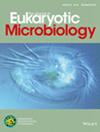Morphology, Systematics and Life Cycle of Ozanamia fimbriatus (Haptista: Centroplasthelida), With Notes on Evolution of Organic Skeleton in Centrohelids
Abstract
The majority of centrohelids bear coverings that consist either of siliceous scales or organic spicules. Strains carrying organic spicules appear in all major clades of scale-bearing centrohelids. Sometimes they represent alternative life cycle stages of scale-bearing species, whereas in other cases such strains do not alternate their morphology. Studying this “siliceous-organic” polymorphism is instrumental to understanding centrohelid diversity and evolution. The genus Chlamydaster has unique organic coverings that are formed with a mucous sheath and seemingly lack skeletal elements. Two centrohelid strains matching the description of Chlamydaster fimbriatus were isolated in clonal cultures and studied with the use of light and electron microscopy. The mucous sheath was shown to be covered with short, crisscrossed spicules. One of the strains formed cysts with siliceous spine scales, whereas the other did not encyst. SSU rDNA-based molecular phylogenetics placed the strains into the scale-bearing genus Ozanamia, distant from the type species of Chlamydaster. The new combination Ozanamia fimbriatus (Penard 1904) Drachko was established. The implications of Chlamydaster non-monophyly and the role of the “siliceous-organic” polymorphism in encystment were discussed.

 求助内容:
求助内容: 应助结果提醒方式:
应助结果提醒方式:


